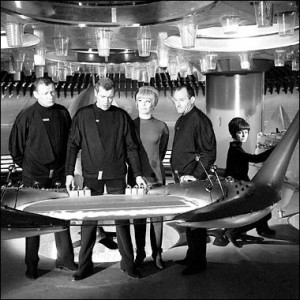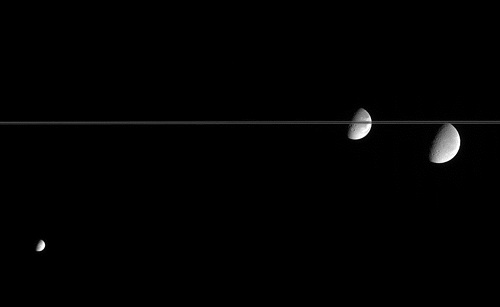Interesting chemistry on the surface of Saturn’s moon Rhea seems a natural conclusion following the announcement of the discovery of oxygen in its evanescent atmosphere. And what a difference from Saturn’s largest moon, Titan, whose atmosphere is not only thick, but packed with nitrogen and methane, with little trace of carbon dioxide or oxygen. Rhea’s tenuous exosphere, which includes carbon dioxide, is so thin that its density of oxygen is about five trillion times lower than that of Earth’s atmosphere. Even so, interesting things may happen on an icy surface in this scenario.

I’m diverted as I write this — pardon the digression, but this does come back to Rhea — because I’m thinking about German friends who are fans of the wonderful 1960’s television show Raumpatrouille (Space Patrol), which followed the adventures of the spaceship Orion some years before Star Trek ever appeared on German screens. First broadcast in 1966, Space Patrol went on to achieve true cult status in West Germany and has legions of fans even today, with numerous novels following long after the show’s demise. And a true Space Patrol fan knows that in episode one, Captain McLane takes the Orion down to the icy surface of Rhea, a place Star Trek‘s Captain Kirk never ventured.
Image: A scene from Space Patrol. Credit: Bavaria Atelier GmbH.
But enough of 1960’s television. The evidence for both oxygen and carbon dioxide on Rhea comes from the continuing work of the Cassini mission. The assessment that accompanies it is that high-energy particles striking the surface dislodge atoms, molecules and ions into the atmosphere. We’re looking, then, at the chemical decomposition of surface water ice as it is radiated by plasma from Saturn’s magnetosphere, an indication that radiation can create complex chemistry on small, icy worlds like this one. Ben Teolis (Southwest Research Institute), a Cassini team scientist and lead author of the paper on this work, thinks processes like this may be widespread:
“The new results suggest that active, complex chemistry involving oxygen may be quite common throughout the solar system and even our universe,” said Teolis. “Such chemistry could be a prerequisite for life. All evidence from Cassini indicates Rhea is too cold and devoid of the liquid water necessary for life as we know it.”
But translate these results to an icy object with liquid water under the surface. According to Teolis (see this JPL news release), if a mechanism existed to transport oxygen and carbon dioxide from the surface to a sub-surface ocean, complex compounds might flourish and lead to the formation of life. As Saturn keeps insisting to us through its varied moons, the earliest precursors of life may be relatively common. “Rhea is turning out to be much more interesting than we had imagined,” says Cassini project scientist Linda Spilker (JPL). But then, that’s been true of almost all the large moons we’ve looked at around our gas giants.

Image: This fantastic view shows, from left to right, Saturn’s moons Mimas, Dione and Rhea, on the far side of Saturn’s nearly edge-on rings. The trailing hemispheres of all three moons are sunlit here, and wispy markings can be seen on the limbs of both Dione and Rhea. The diameter of Mimas is 397 kilometers, Dione is 1,118 kilometers and Rhea is 1,528 kilometers. The image was taken in visible blue light with the Cassini spacecraft narrow-angle camera on March 15, 2005, at a distance of approximately 2.4 million kilometers from Saturn. The image scale is 14 kilometers per pixel. Credit: NASA/JPL/Space Science Institute.
So how much oxygen are we talking about? The Cassini plasma spectrometer, and in particular its electron spectrometer, found peak densities of oxygen of around 50 billion molecules per cubic meter, with carbon dioxide levels at 20 billion molecules per cubic meter. Moreover, the plasma spectrometer saw strong indications of streams of positive and negative ions with masses that corresponded to ions of oxygen and carbon dioxide. The assumption that the oxygen in Rhea’s atmosphere comes from surface water ice seems reasonable given the rate at which Saturn’s magnetic field sprays the surface with energetic particles trapped in the field.
The carbon dioxide is susceptible to other interpretations, perhaps the irradiation of organic molecules trapped in Rhea’s water ice, but possibly the result of dry ice dating back to the solar nebula. A third possibility: Carbon dioxide could be the remnant of carbon-rich materials left by meteor strikes, all of which fits with the dark, carbon-based coating that appears on the surface.
The paper is “Cassini Finds an Oxygen-Carbon Dioxide Atmosphere on Saturn’s Icy Moon Rhea,” Science Express 26 November 2010 (abstract).



It has been suggested by several authors that the mechanisms for high percentages, or large quantities, of free oxygen could be an indication of life. Oxygen on Rhea can have several explanations, the least likely… at this stage of exploration… being indigenous life.
An active space patrol would find out…
Cosmic rays can penetrate tens of meters into materials so I would think oxygen would be more concentrated in the water ice than at its surface provided it is cold enough to prevent recombination with free hydrogen.
Well a similar phenomenon is known on Jupiter’s icy moons Europa and Ganymede (both of which probably do have liquid oceans below the surface), so this is certainly not the first time oxygen atmospheres have been detected on ice moons: it probably would be more surprising if Rhea did NOT have an oxygen atmosphere.
To Paul Gilster, I bet you will be covering the NASA news release on thursday. I wonder what exactly there’re going to tell us? I’m guessing it has something to do with possible hints of biological activity on Mars in the past.
That is my best guess. Do you think we got time to set-up a betting pool?
Possible biological explanation for arsnic chemistry on Titan?
Mike, better move fast if you’re going to set up the betting pool! Maybe better to set up a pool on first terrestrial planet in the habitable zone…
It seems to me that volatile resources found anywhere in the solar system just lend strength to the proponents of missions capable of self-refueling, whether robotic or manned. With launch costs remaining high, it’s good news any time we don’t have to push something out of our own gravity well to make a mission viable. Yes, this adds complexity and risk to mission design, but it’s technology development that will eventually be useful regardless of launch cost.
Besides, I’m not really interested in complexity arguments given the seemingly-crazy skycrane design for the Curiosity Mars rover delivery system, and given so many other robotic missions that have succeeded admirably in the past decades. No risk, no reward. It’s not like we don’t possess the needed tools; we just haven’t tested many of them off Earth’s surface. It’s past time.
Hi All
The oxygen atmospheres of Rhea, Europa and Ganymede are all incredibly tenuous. The total mass of gas is just a few thousand tonnes at most. The critical question is just how fast do the oxygen atmospheres leak into space and how quickly are they replenished. Both Europa and Ganymede have sufficient gravity to hang on to oxygen molecules if Jeans escape was the only loss mechanism, but the main loss process seems to be the ion-bombardment which splits the oxygen from the ice to start with. Even Ganymede’s significant intrinsic magnetic field doesn’t seem quite enough to keep the ion-blast away.
Personally I reckon the NASA news release will be the discovery of organisms using arsenic-based biochemistry in Mono Lake. Most likely a bunch of archaea which are using a neat chemical trick (after all, archaea are the usual suspects in the whole weird lifestyle area), perhaps less likely definitive indications of a “shadow biosphere” implying a second origin-of-life event on this planet.
I love the reference to “Raumschiff Orion”. It reminds me so much of my youth, when I was glued to the (black & white) TV watching this series whenever I could, along with any number of mostly American science fiction movies (Silent Running, Zardoz, and Soylent Green come to mind).
The Orion was sea-launched from the bottom of the ocean, as I remember, with an impressive fish tank as a backdrop for scenes before launch. The helm of the ship resembled, and as I recall actually was, a clothes iron.
Saturn’s “Wispy” Moon Has An Oxygen Atmosphere
by Jason Major on March 3, 2012
There’s oxygen around Dione, one of Saturn’s 62 known moons, a research team led by scientists at New Mexico’s Los Alamos National Laboratory announced on Friday.
The presence of molecular oxygen around Dione creates an intriguing possibility for organic compounds — the building blocks of life — to exist on other outer planet moons.
Full article here:
http://www.universetoday.com/93959/saturns-wispy-moon-has-an-oxygen-atmosphere/#